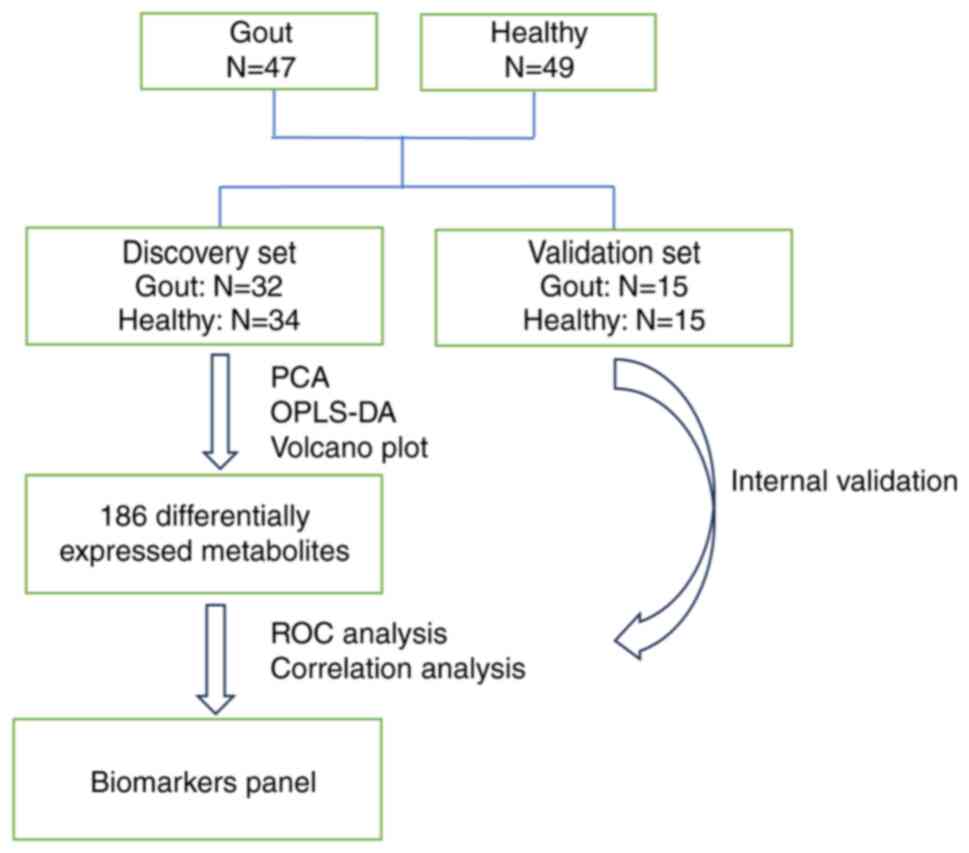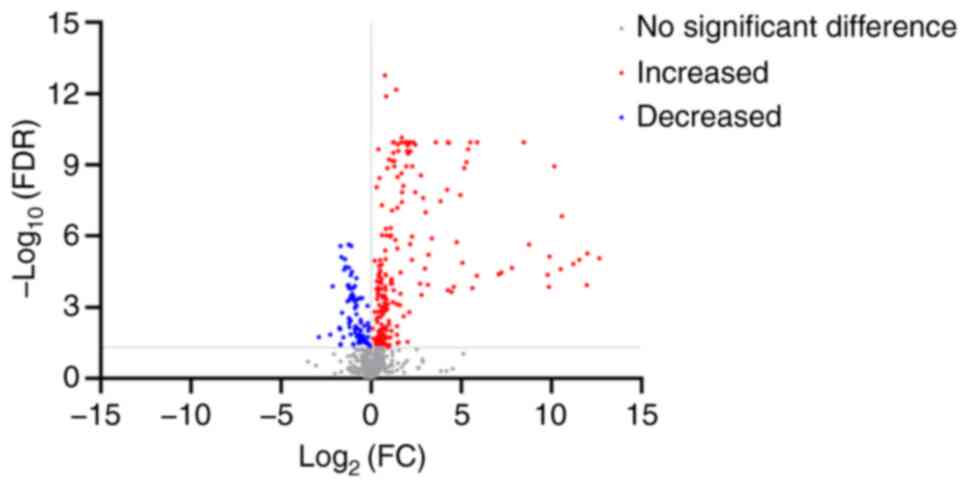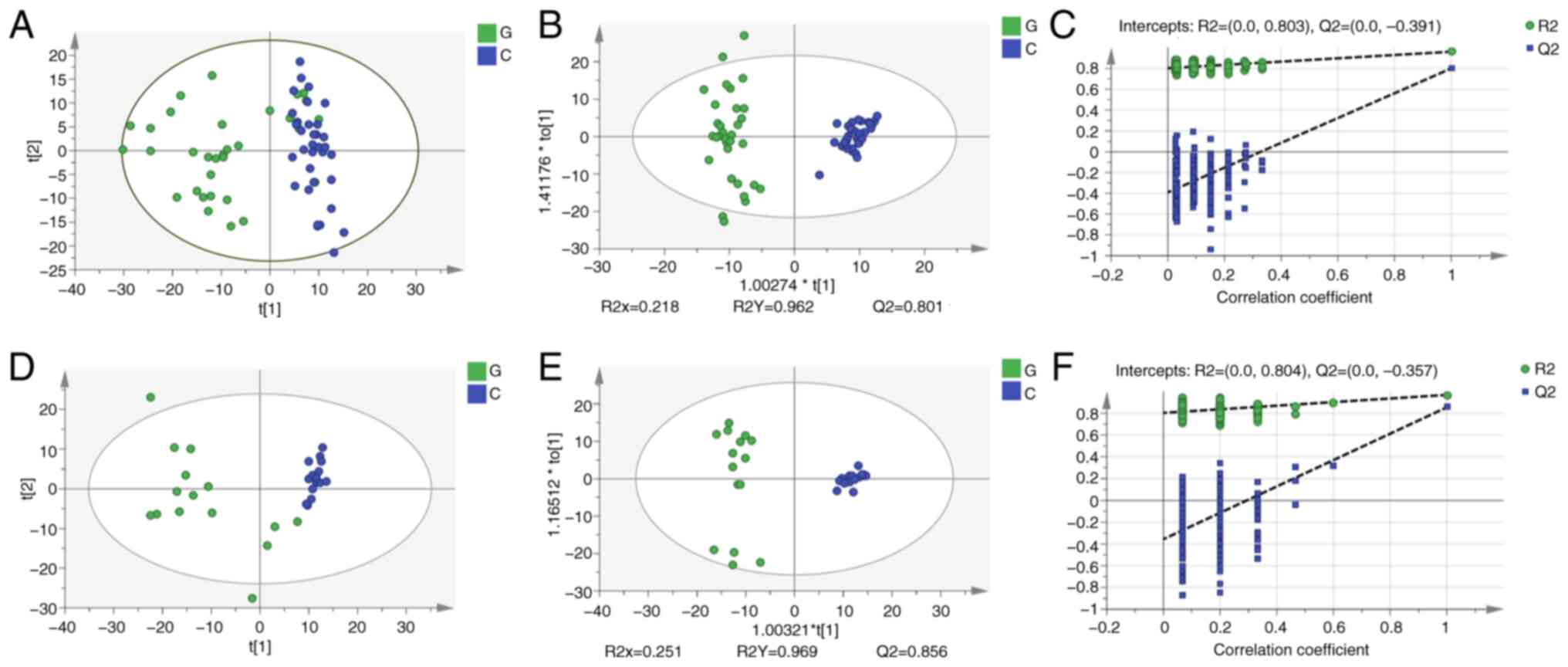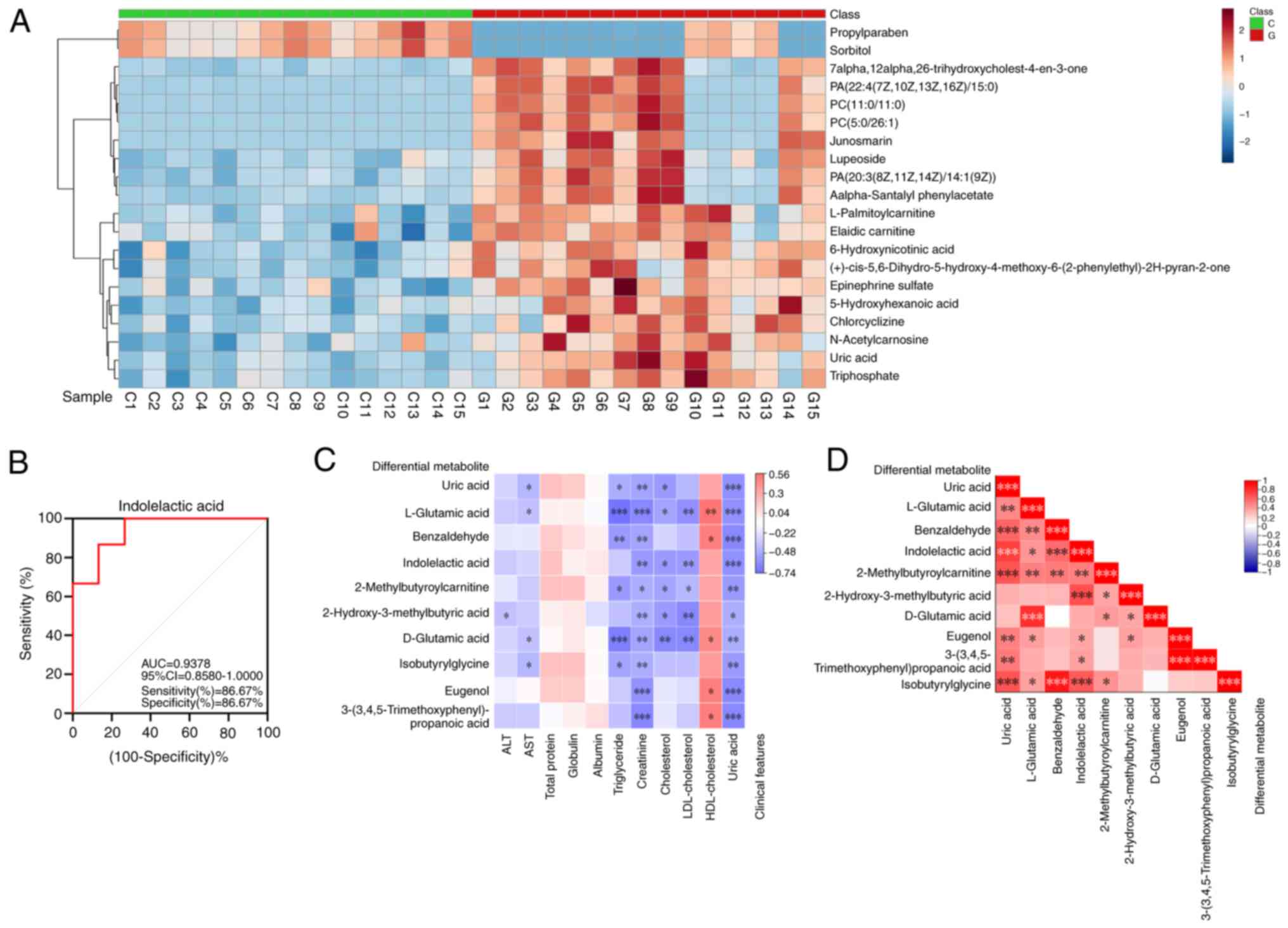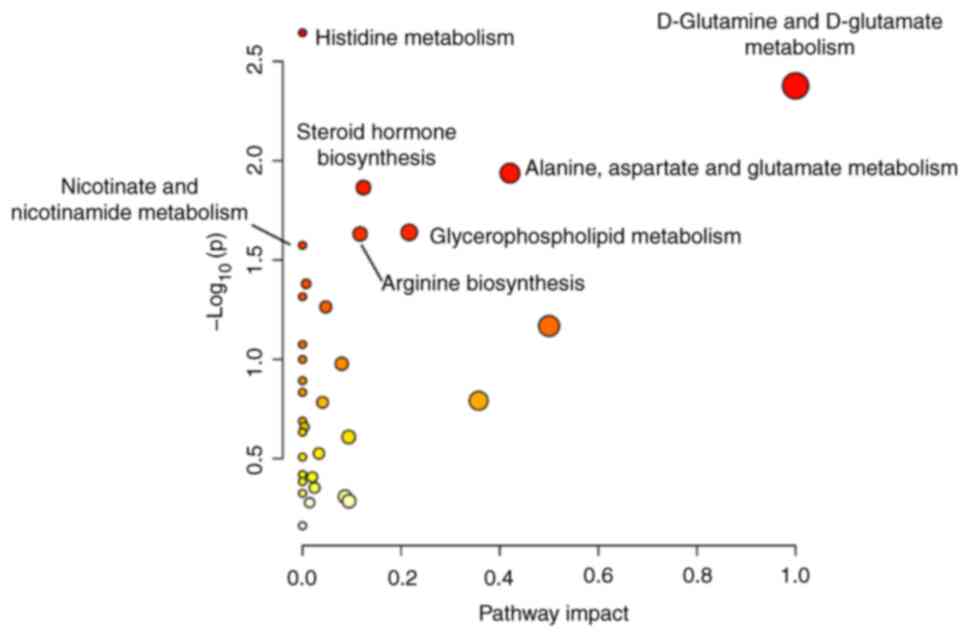Indolelactic acid as a potential metabolic biomarker for diagnosing gout
- Authors:
- Published online on: September 16, 2024 https://doi.org/10.3892/etm.2024.12717
- Article Number: 429
-
Copyright: © Zhang et al. This is an open access article distributed under the terms of Creative Commons Attribution License.
Abstract
Introduction
Gout is a chronic inflammatory disease caused by monosodium urate (MSU) crystal deposition. The clinical manifestations of gout are paroxysmal single joint synovitis, severe pain, swelling and fever, but these symptoms are self-limiting (1). Although acute gout symptoms may subside within a few days, the long-term deposition of MSU crystals can lead to the formation of tophi, leading to bone destruction (2).
Epidemiological surveys report that the prevalence of gout among all age groups in the United States was 3.9% from 2007-2016(3). The prevalence of gout in Australia in 2015 was 6.8% (4) and 3.8% in Canada in 2012(5). The prevalence of gout in South Korea increased over 2007-2015 from 0.35-0.76% and is expected to reach 1.66% by 2025(6). In China, the prevalence of gout is 1.1%, and the prevalence of gout in men (1.5%) is higher than that in women (0.9%) (7). Measurement of serum urate levels can be used for the clinical diagnosis of gout in symptomatic individuals, but this may not be feasible, as certain patients with hyperuricemia do not have gout, since the increase of blood uric acid level may not necessarily lead to gout, but hyperuricemia is the most important biochemical basis of gout, and urate crystal deposition is the result of hyperuricemia; therefore, more reliable biomarkers are needed to improve the diagnosis of gout.
Gout is a metabolic disease associated with a permanent imbalance of certain metabolites (8). Non-targeted metabolomics is the hypothesis-generating, global unbiased analysis of all small-molecule metabolites present within a biological system, under a given set of conditions (9). Liquid chromatography-mass spectrometry (LC-MS) is the main technical platform used for metabolic analysis (10). Metabolomics has been used in disease diagnosis and detection, and it is important for the early diagnosis and treatment of disease (11,12). Therefore, there is an urgent need to use metabolomics to identify novel biomarkers related to the occurrence and development of gout to prevent acute attacks and joint destruction in patients with gouty arthritis.
A number of studies have reported metabolic differences between patients with gout and healthy subjects and have shown that amino acid metabolism is important for regulating serum uric acid (UA) levels (13,14). In the pathogenesis of gout, a large number of amino acids are consumed, and among 19 amino acids, the levels of 10 amino acids (alanine, glycine, isoleucine, leucine, methionine, phenylalanine, proline, serine, tryptophan, valine) differed significantly in one study, which suggests that amino acids may serve an important role in gout pathogenesis (14). The purine metabolic pathway is also closely related to the occurrence of gout. UA is the final product of purine metabolism. When purine nucleotide synthesis is disrupted, the serum concentration of UA increases (15). Furthermore, urate crystals are formed, causing gouty inflammation (16).
To date, the systematic analysis of nontargeted metabolomics features to determine potential biomarkers for predicting or diagnosing gout in human cohorts has not commonly been performed. The present study objectives were as follows: i) To explore serum metabolic changes in patients with gout and healthy subjects and capture metabolic changes associated with gout progression; ii) to screen potential metabolic biomarker groups in patients with gout; and iii) to screen potential pathways for the treatment of gout.
Materials and methods
Participants and study design
A total of 47 patients with gout who met the classification criteria approved by The European League Against Rheumatism Executive Committee and from the outpatient ward of the Affiliated Hospital of Nanjing University of Traditional Chinese Medicine (Nanjing, China) from June 2020 to January 2023(17). A total of 49 healthy volunteers without rheumatic diseases, were recruited from the Health Counseling and Physical Examination Center of the Affiliated Hospital of Nanjing University of Traditional Chinese Medicine at the same time. The patients with gout and healthy subjects were randomly assigned to the discovery set (34 healthy individuals and 32 patients with gout) and the validation set (15 healthy individuals and 15 patients with gout), respectively, at a 7:3 ratio based on previously published literature (18,19). The present study was approved by the Ethics Committee of the Affiliated Hospital of Nanjing University of Traditional Chinese Medicine (approval no. 2019NL-129-02; Nanjing). Written informed consent was obtained from the participants, who abided by the principle of privacy protection. The patients with gout and the healthy individuals were aged 18-70 years, were male or female, did not suffer from other rheumatic diseases and had not used long-term drugs or treatments, such as anti-inflammatory drugs, for 3 months. LC-MS/MS technology was used to analyze the peripheral blood of the two groups of patients and potential differential markers related to gout were identified (Fig. 1). Logistic regression and receiver operating characteristic (ROC) analyses were used. Kyoto Encyclopedia of Genes and Genomes (KEGG) and MetaboAnalyst databases (https://www.metaboanalyst.ca/) were used to analyze the pathways associated with the differentially expressed metabolites and identify the metabolic pathways of patients with gout.
Sample preparation and metabolomics profiling
A Vanquish ultrahigh-performance liquid chromatograph (Thermo Fisher Scientific, Inc.) was used to separate the target compounds using a Waters ACQUITY UPLC HSS T3 (2.1x100 mm; 1.8 µm) liquid chromatography column. The Orbitrap Exploris 120 mass spectrometer, which can perform primary and secondary mass spectrometry data acquisition, was also used (Xcalibur; version 4.4; Thermo Fisher Scientific, Inc.). LC-MS/MS analyses were performed using an UHPLC system (Vanquish; Thermo Fisher Scientific, Inc.) with a UPLC HSS T3 column (2.1x100 mm; 1.8 µm) coupled to an Orbitrap Exploris 120 mass spectrometer (Orbitrap MS; Thermo Fisher Scientific, Inc.). The mobile phase consisted of 5 mmol/l acetate and 5 mmol/l acetic acid in water (A) and acetonitrile (B). The auto-sampler temperature was 4˚C, and the injection volume was 2 µl. The Orbitrap Exploris 120 mass spectrometer was used for its ability to acquire MS/MS spectra on information-dependent acquisition mode in the control of the acquisition software (Xcalibur; Thermo Fisher Scientific, Inc.). In this mode, the acquisition software continuously evaluates the full scan MS spectrum. The ESI source conditions were set as following: Sheath gas flow rate, 50 Arb; Aux gas flow rate, 15 Arb; capillary temperature, 320˚C; full MS resolution, 60,000; MS/MS resolution, 15,000; collision energy, 10/30/60 in NCE mode; and spray voltage, 3.8 kV (positive) or -3.4 kV (negative).
Data processing and normalization
After the original data were converted into the mzXML format using ProteoWizard (http://www.proteowizard.org/index.html), the peak recognition, peak extraction, peak alignment and integrals were processed using the self-written R package (Kernel XCMS). To reduce the influence of detection system errors on the results and ensure that the results better highlighted the biological significance, a series of data management steps were performed using the original data. This approach included the following steps: i) Deviation value filtering where a single peak was filtered to remove the noise and the deviation values were filtered based on the relative standard deviation and coefficient of variation; ii) missing value filtering where a single peak was filtered and only peak area data with a single set of null values ≤50% or all group null values ≤50% were retained; iii) missing value filling where the missing values in the original data were simulated and the numerical simulation method filled half of the minimum value; and iv) data normalization where a mixed isotope internal standard [succinic acid-2,2,3,3-d4,L-leucine-5,5,5-d3, (RING-2H5)-L-phenylalanine,2-chloro-L-phenylalanine] was used for normalization.
Statistical analysis
The significance of each metabolite was analyzed using the Mann-Whitney Wilcoxon test and the false discovery rate (FDR) was used for data correction. P<0.05 was considered to indicate a statistically significant difference. Then, the standardized data were imported into SIMCA-P (version 14.1; Sweden Umetrics) for principal component analysis (PCA) to observe the aggregation of samples. Orthogonal partial least squares discriminant analysis (OPLS-DA) was further used to assess the difference between the patients with gout and the healthy control group. The processed data were subjected to MetaboAnalyst (version 5.0; http://www.metaboanalyst.ca/). All data in this article were analyzed by one-way ANOVA using GraphPad Prism (version 9.5.1; Dotmatics), followed by ROC and correlation analysis. Correlation analysis and mapping were performed using SPSS (version 27.0; IBM Corp.) and Origin (version 2022; OriginLab Corporation). Endogenous biomarkers were identified using the Human Metabolomics Database (http://www.hmdb.ca/). KEGG (http://www.genome.jp/) and metabolic analysis were used to identify related metabolic pathways.
Results
Clinical characteristics of the enrolled participants
Patient age, C-reactive protein, erythrocyte sedimentation rate, uric acid, alanine transaminase, aspartate aminotransferase, creatinine, triglycerides, total cholesterol and low-density lipoprotein (LDL) cholesterol were significantly increased in the patients with gout compared with those in the healthy control group, while high-density lipoprotein cholesterol was decreased. The changes in total protein, albumin and globulin were not statistically significant (Table I). Although subjects with other metabolic diseases were excluded to minimize confounding factors, the aforementioned differences still existed, indicating that these indicators may change during the onset of gout.
Nontargeted metabolomics study for healthy subjects and patients with gout
Nontargeted metabolomics analysis was performed using an LC-MS/MS system quadrupole-electrostatic field orbital trap Orbitrap mass spectrometer, and 26,854 peaks were detected in positive and negative ionization modes. After data collation and standardization, 991 metabolites were identified. Through the Mann-Whitney Wilcoxon test combined with FDR correlation analysis, 295/991 compounds showed significant differences in metabolic characteristics. Of these compounds, 207 were significantly more abundant in patients with gout compared with healthy subjects, while 88 of these compounds were significantly less abundant (Fig. 2). Unsupervised PCA was used to compare the metabolic profiles between patients with gout and healthy individuals to assess the difference between the two groups of patients, and then OPLS-DA was used to demonstrate that there was a significant overall separation between patients with gout and healthy individuals. The PCA plot indicated that there was a significant metabolic difference between patients with gout and healthy subjects at the molecular level (Fig. 3A). The cumulative R2Y and Q2 of the discovery set were 0.962 and 0.801, respectively (Fig. 3B), which also indicated that there was a significant metabolic difference, consistent with the results shown in the PCA plot. The OPLS model was verified using a permutation test. These results demonstrated that the Y intercept of R2 was 0.803 and the Y intercept of Q2 was 0.391 (Fig. 3C), which indicated that the model significantly differed between patients with gout and healthy subjects, and was reliable. The difference between the group of patients with gout and the healthy group was also obvious and the model was more reliable in the validation set than the discovery set (Fig. 3D-F). These observations were used to further explore metabolites that could potentially be used to identify the development of gout.
According to the parameters of VIP ≥1.0, P<0.05 and adjusted P≤0.05, 186 differentially expressed metabolites were identified (Table SI). A visual cluster analysis of the 186 differentially expressed metabolites was performed using a heatmap and the top 20 differentially expressed metabolites were selected for further analysis. The metabolites which were significantly different between the group of patients with gout compared with the healthy control group were separated according to the heatmap, which provided a visual display of the overall distribution of metabolic differences between the groups (Fig. 4A).
Biomarker panel for the diagnosis of patients with gout compared with healthy. participants
The group of biomarkers for the diagnosis of patients with gout were screened according to the area under the ROC curve (AUC). The top 10 endogenous metabolites with the highest diagnostic rates were UA, L-glutamic acid, benzaldehyde, indolelactic acid (ILA), 2-methylbutyroylcarnitine and 2-hydroxy-3-methylbutyric acid, D-glutamic acid, isobutyrylglycine, eugenol and 3-(3,4,5-trimethoxyphenyl)propanoic acid, which had AUC values of 0.9511, 0.9467, 0.9422, 0.9378, 0.9289, 0.9244, 0.9156, 0.9156, 0.9067 and 0.9022, respectively (Fig. S1). Among these biomarkers, ILA could be used to successfully distinguish between the patients with gout and the healthy group when used as a diagnostic marker. The AUC value in the discovery set reached 0.9378, the sensitivity was 86.67%, the specificity was 86.67% and the 95% CI was 0.8580-1.000 (Fig. 4B).
Biomarker correlation analysis
Spearman correlation analysis was performed between the top 10 differentially abundant metabolites and clinical indicators revealed that triglycerides, creatinine, cholesterol, LDL-cholesterol and UA were significantly correlated with differentially abundant metabolites. Among the metabolites, L-glutamic acid and D-glutamic acid were the most related to clinical indicators. The correlations of UA, ILA, 2-methylbutyroylcarnitine and 2-hydroxy-3-methylbutyric acid were also positive, followed by benzaldehyde, isobutyrylglycine, eugenol and 3-(3,4,5-trimethoxyphenyl)propanoic acid (Fig. 4C). A correlation heatmap was produced to represent the different markers between patients with gout and healthy individuals (Fig. 4D). Each small square represented the correlation coefficient between the metabolites and the red color represented a positive correlation, whereas blue represented a negative correlation. The darker the color, the more related the compound is to gout. The correlations between the 10 endogenous compounds demonstrated that the levels of ILA and the other nine metabolic compounds were closely related and significant.
Pathway analysis
Pathway enrichment analysis demonstrated that the aforementioned metabolites were involved in 29 metabolic pathways. The identified metabolites were significantly enriched in pathways such as the malate-aspartate shuttle, beta-alanine metabolism and aspartate metabolism (Fig. S2). Pathway bubble diagram analysis demonstrated that six pathways, namely, histidine metabolism, D-glutamine and D-glutamate metabolism, alanine, aspartate and glutamate metabolism, steroid hormone biosynthesis, glycerophospholipid metabolism and arginine biosynthesis, were significantly differentially expressed between the patients with gout and the healthy group. Among these pathways, D-glutamine and D-glutamate metabolism were identified as the key nodes (Fig. 5).
Discussion
According to the results of the present study, UA was demonstrated to be the metabolite with the highest AUC, which suggested that UA may have the potential to distinguish patients with gout compared with healthy individuals, a finding which has been previously reported (20). However, considering the recurrence and irregularity of gout, UA is not sufficient as a single differential marker for the clinical diagnosis of gout.
The differentially abundant metabolite with an AUC second to that of UA was L-glutamic acid. Mahbub et al (14) reported a positive correlation between alanine, isoleucine, leucine, phenylalanine, tryptophan and valine levels with gout, and glycine and serine levels were negatively correlated with gout. As early as 1969, Pagliara and Goodman reported that fasting plasma glutamate concentrations in patients with gout were greater than those compared with healthy people. The increase in glutamate may be causally related to the overproduction of purines in gout (21). Glutamate is an essential amino acid required for the de novo synthesis of purines, therefore, the content changes in amino acids may affect UA production.
ILA is a metabolite of tryptophan breakdown and it has been reported that plasma levels of this marker are reduced in patients with cachexia (22), which can also be used as a different marker in the cord serum of newborns with preeclampsia (23). The association between tryptophan and gout has been previously reported (24), but the association between ILA and patients with gout has not yet been reported.
The differential marker 2-methylbutyroylcarnitine has been reported to be important in diseases related to metabolic disorders induced by a high fat diet and childhood obesity-related traits in Mexican-American children (25,26). Huang et al (27) reported that the levels of 2-methylbutyroylcarnitine in the serum of patients with gout were significantly greater compared with that of healthy people.
Isobutyrylglycine was reported to be a potential biomarker for the diagnosis of ulcerative colitis and acquired pneumonia (28,29). Abnormal increase of isobutyrylglycine in urine can cause the production of glutaric aciduria type II (30). Organic acidemia is an amino acid metabolic disorder that disrupts normal amino acid metabolism causing a build-up of branched-chain amino acids, which is consistent with the metabolic pathway of gout development (31). However, no studies to date have reported an association of isobutyrylglycine and 2-hydroxy-3-methylbutyric acid with gout, which requires further exploration in the future.
Eugenol is biosynthesized from tyrosine and has antioxidant and antiproliferative effects (32). Anti-inflammatory activities have potential roles in preventing cancer and inflammatory reactions (33,34). Eugenol may have a potential role in the treatment of gouty arthritis.
Another differentially expressed metabolite in the serum of patients with gout and healthy people was 3-(3,4,5-trimethoxyphenyl)propanoic acid (27,35).
In summary, LC-MS-based nontargeted metabolomics was used to detect serum changes in healthy people and patients with gout. These results demonstrated significant metabolomic differences between healthy subjects and patients with gout. ILA may potentially serve as a potential biomarker for diagnosing gout and could be used for the early detection or prediction of gout progression. The present study has several limitations. First, due to the demographics of the patients with gout, a large number of the patients included in the study were younger than the healthy subjects and the majority of patients with gout were men, therefore, the two groups were not comparable in age or sex. Second, the small sample size is a limitation of the present study. The limitations of the results of the present study are with regard to age, which was increased due to selection bias. The lack of data for patient height, weight and BMI were also a limitation of the present study. Due to the two groups not being randomized or matched, there was a high risk of selection bias in the present study. The ratio of 2:1 or 7:3 was used to divide individuals into groups in previous studies (18,19). However, when processing the data in the early stage of the present study, it was found that the samples after 2:1 distribution were scattered, so the ratio of 7:3 was selected to randomly distribute the samples. In the future, longitudinal studies should be carried out in combination with other omics studies, including proteomics and genomics, or machine learning to identify additional potential biomarkers and pathways involved in gout (36). In conclusion, the present study demonstrated that ILA may serve as a potential biomarker for diagnosing gout and could be used for the early detection or prediction of gout progression in the future.
Supplementary Material
ROC curves of the top 10 differentially expressed endogenous metabolites in patients with gout compared with healthy subjects. (A) Uric acid, (B) L-glutamic acid, (C) benzaldehyde, (D) indolelactic acid, (E) 2-methylbutyroylcarnitine, (F) 2-hydroxy-3-methylbutyric acid, (G) D-glutamic acid, (H) isobutyrylglycine, (I) eugenol and (J) 3-(3,4,5-trimethoxyphenyl) propanoic acid. AUC, area under the ROC curve.
Metabolomic pathway enrichment analysis of healthy subjects compared with patients with gout. CoA, coenzyme A.
Differentially expressed metabolites from healthy subjectscompared with patients with gout.
Acknowledgements
Not applicable.
Funding
Funding: This study was financially supported by The Talent Project established by Chinese Pharmaceutical Association Hospital Pharmacy Department (grant no. CPA-Z05-ZC-2023-003), The Jiangsu Provincial Administration of Traditional Chinese Medicine (grant nos. 2020ZX09 and MS2022014), The Special Fund for Science and Technology Plan of Jiangsu Province in 2023 (Key Research and Development Plan Social Development Project) (grant no. BE2023607) and The Project of Jiangsu Province Hospital of Traditional Chinese Medicine (grant no. y2021rc36).
Availability of data and materials
The data generated in the present study may be found in the EMBL-EBI database under accession number MTBLS10032 or at the following URL: www.ebi.ac.uk/metabolights/MTBLS10032.
Authors' contributions
YL, SL and TZ designed the study. SW and JZ recruited patients for the study and collected serum samples. YZ, JS and KZ collected the data, performed the statistical analyses, interpreted the data and wrote the manuscript. All authors read and approved the final version of the manuscript. YL and SL confirm the authenticity of all the raw data.
Ethics approval and consent to participate
The study was conducted in accordance with the Declaration of Helsinki and approved by the Ethics Committee of the Affiliated Hospital of Nanjing University of Traditional Chinese Medicine (approval no. 2019NL-129-02).
Patient consent for publication
Not applicable.
Competing interests
The authors declare that they have no competing interests.
References
|
Dalbeth N, Gosling AL, Gaffo A and Abhishek A: Gout. Lancet. 397:1843–1855. 2021.PubMed/NCBI View Article : Google Scholar | |
|
Petty HR, Rathod-Mistry T, Menz HB and Roddy E: Foot structure, pain and functional ability in people with gout in primary care: Cross-sectional findings from the clinical assessment study of the foot. J Foot Ankle Res. 12(8)2019.PubMed/NCBI View Article : Google Scholar | |
|
Singh G, Lingala B and Mithal A: Gout and hyperuricaemia in the USA: Prevalence and trends. Rheumatology (Oxford). 58:2177–2180. 2019.PubMed/NCBI View Article : Google Scholar | |
|
Pisaniello HL, Lester S, Gonzalez-Chica D, Stocks N, Longo M, Sharplin GR, Dal Grande E, Gill TK, Whittle SL and Hill CL: Gout prevalence and predictors of urate-lowering therapy use: Results from a population-based study. Arthritis Res Ther. 20(143)2018.PubMed/NCBI View Article : Google Scholar | |
|
Rai SK, Aviña-Zubieta JA, McCormick N, De Vera MA, Shojania K, Sayre EC and Choi HK: The rising prevalence and incidence of gout in British Columbia, Canada: Population-based trends from 2000 to 2012. Semin Arthritis Rheum. 46:451–456. 2017.PubMed/NCBI View Article : Google Scholar | |
|
Kim JW, Kwak SG, Lee H, Kim SK, Choe JY and Park SH: Prevalence and incidence of gout in Korea: Data from the national health claims database 2007-2015. Rheumatol Int. 37:1499–1506. 2017.PubMed/NCBI View Article : Google Scholar | |
|
Liu R, Han C, Wu D, Xia X, Gu J, Guan H, Shan Z and Teng W: Prevalence of hyperuricemia and gout in Mainland China from 2000 to 2014: A systematic review and meta-analysis. Biomed Res Int. 2015(762820)2015.PubMed/NCBI View Article : Google Scholar | |
|
Li X, Gao J and Tao J: Purinergic signaling in the regulation of gout flare and resolution. Front Immunol. 12(785425)2021.PubMed/NCBI View Article : Google Scholar | |
|
Richette P, Doherty M, Pascual E, Barskova V, Becce F, Castañeda-Sanabria J, Coyfish M, Guillo S, Jansen TL, Janssens H, et al: 2016 Updated EULAR evidence-based recommendations for the management of gout. Ann Rheum Dis. 76:29–42. 2017.PubMed/NCBI View Article : Google Scholar | |
|
Fraga-Corral M, Carpena M, Garcia-Oliveira P, Pereira AG, Prieto MA and Simal-Gandara J: Analytical metabolomics and applications in health, environmental and food science. Crit Rev Anal Chem. 52:712–734. 2022.PubMed/NCBI View Article : Google Scholar | |
|
Chen J, Li T, Huang D, Gong W, Tian J, Gao X, Qin X, Du G and Zhou Y: Integrating UHPLC-MS/MS quantitative analysis and exogenous purine supplementation to elucidate the antidepressant mechanism of Chaigui granules by regulating purine metabolism. J Pharm Anal. 13:1562–1576. 2023.PubMed/NCBI View Article : Google Scholar | |
|
Liu Y, Zhang X, Lin W, Kehriman N, Kuang W and Ling X: Multi-factor combined biomarker screening strategy to rapidly diagnose Alzheimer's disease and evaluate drug effect based on a rat model. J Pharm Anal. 12:627–636. 2022.PubMed/NCBI View Article : Google Scholar | |
|
Yü TF, Adler M, Bobrow E and Gutman AB: Plasma and urinary amino acids in primary gout, with special reference to glutamine. J Clin Invest. 48:885–894. 1969.PubMed/NCBI View Article : Google Scholar | |
|
Mahbub MH, Yamaguchi N, Takahashi H, Hase R, Amano H, Kobayashi-Miura M, Kanda H, Fujita Y, Yamamoto H, Yamamoto M, et al: Alteration in plasma free amino acid levels and its association with gout. Environ Health Prev Med. 22(7)2017.PubMed/NCBI View Article : Google Scholar | |
|
Dalbeth N, Choi HK, Joosten LAB, Khanna PP, Matsuo H, Perez-Ruiz F and Stamp LK: Gout. Nat Rev Dis Primers. 5(69)2019.PubMed/NCBI View Article : Google Scholar | |
|
Li Q, Wei S, Wu D, Wen C and Zhou J: Urinary metabolomics study of patients with gout using gas chromatography-mass spectrometry. Biomed Res Int. 2018(3461572)2018.PubMed/NCBI View Article : Google Scholar | |
|
Neogi T, Jansen TLTA, Dalbeth N, Fransen J, Schumacher HR, Berendsen D, Brown M, Choi H, Edwards NL, Janssens HJEM, et al: 2015 Gout classification criteria: An American college of rheumatology/European league against rheumatism collaborative initiative. Ann Rheum Dis. 74:1789–1798. 2015.PubMed/NCBI View Article : Google Scholar | |
|
Liu H, Xu M, He Q, Wei P, Ke M and Liu S: Untargeted serum metabolomics reveals specific metabolite abnormalities in patients with Crohn's disease. Front Med (Lausanne). 9(814839)2022.PubMed/NCBI View Article : Google Scholar | |
|
Luan H, Gu W, Li H, Wang Z, Lu L, Ke M, Lu J, Chen W, Lan Z, Xiao Y, et al: Serum metabolomic and lipidomic profiling identifies diagnostic biomarkers for seropositive and seronegative rheumatoid arthritis patients. J Transl Med. 19(500)2021.PubMed/NCBI View Article : Google Scholar | |
|
Kuo CF, Grainge MJ, Mallen C, Zhang W and Doherty M: Comorbidities in patients with gout prior to and following diagnosis: Case-control study. Ann Rheum Dis. 75:210–217. 2016.PubMed/NCBI View Article : Google Scholar | |
|
Pagliara AS and Goodman AD: Elevation of plasma glutamate in gout. Its possible role in the pathogenesis of hyperuricemia. N Engl J Med. 281:767–770. 1969.PubMed/NCBI View Article : Google Scholar | |
|
Servià L, Jové M, Sol J, Pamplona R, Badia M, Montserrat N, Portero-Otin M and Trujillano J: A prospective pilot study using metabolomics discloses specific fatty acid, catecholamine and tryptophan metabolic pathways as possible predictors for a negative outcome after severe trauma. Scand J Trauma Resusc Emerg Med. 27(56)2019.PubMed/NCBI View Article : Google Scholar | |
|
Wang X, Liu J, Hui X and Song Y: Metabolomics applied to cord serum in preeclampsia newborns: Implications for neonatal outcomes. Front Pediatr. 10(869381)2022.PubMed/NCBI View Article : Google Scholar | |
|
Liu Z, Jin L, Ma Z, Nizhamuding X, Zeng J, Zhang T, Zhang J, Zhou W and Zhang C: Abnormal kynurenine-pathway metabolites in gout: Biomarkers exploration based on orthogonal partial least squares-discriminant analysis. Clin Chim Acta. 549(117531)2023.PubMed/NCBI View Article : Google Scholar | |
|
Suo H, Shishir MRI, Wang Q, Wang M, Chen F and Cheng KW: Red wine high-molecular-weight polyphenolic complex ameliorates high-fat diet-induced metabolic dysregulation and perturbation in gut microbiota in mice. J Agric Food Chem. 71:6882–6893. 2023.PubMed/NCBI View Article : Google Scholar | |
|
Farook VS, Reddivari L, Chittoor G, Puppala S, Arya R, Fowler SP, Hunt KJ, Curran JE, Comuzzie AG, Lehman DM, et al: Metabolites as novel biomarkers for childhood obesity-related traits in Mexican-American children. Pediatr Obes. 10:320–327. 2015.PubMed/NCBI View Article : Google Scholar | |
|
Huang Y, Xiao M, Ou J, Lv Q, Wei Q, Chen Z, Wu J, Tu L, Jiang Y, Zhang X, et al: Identification of the urine and serum metabolomics signature of gout. Rheumatology (Oxford). 59:2960–2969. 2020.PubMed/NCBI View Article : Google Scholar | |
|
Liu K, Jia B, Zhou L, Xing L, Wu L, Li Y, Lu J, Zhang L and Guan S: Ultraperformance liquid chromatography coupled with quadrupole time-of-flight mass spectrometry-based metabolomics and lipidomics identify biomarkers for efficacy evaluation of mesalazine in a dextran sulfate sodium-induced ulcerative colitis mouse model. J Proteome Res. 20:1371–1381. 2021.PubMed/NCBI View Article : Google Scholar | |
|
Zhou B, Lou B, Liu J and She J: Serum metabolite profiles as potential biochemical markers in young adults with community-acquired pneumonia cured by moxifloxacin therapy. Sci Rep. 10(4436)2020.PubMed/NCBI View Article : Google Scholar | |
|
Popek M, Walter M, Fernando M, Lindner M, Schwab KO and Sass JO: Two inborn errors of metabolism in a newborn: Glutaric aciduria type I combined with isobutyrylglycinuria. Clin Chim Acta. 411:2087–2091. 2010.PubMed/NCBI View Article : Google Scholar | |
|
Reddy N, Calloni SF, Vernon HJ, Boltshauser E, Huisman TAGM and Soares BP: Neuroimaging findings of organic acidemias and aminoacidopathies. Radiographics. 38:912–931. 2018.PubMed/NCBI View Article : Google Scholar | |
|
Jaganathan SK and Supriyanto E: Antiproliferative and molecular mechanism of eugenol-induced apoptosis in cancer cells. Molecules. 17:6290–3304. 2012.PubMed/NCBI View Article : Google Scholar | |
|
Fujisawa S and Murakami Y: Eugenol and its role in chronic diseases. Adv Exp Med Biol. 929:45–66. 2016.PubMed/NCBI View Article : Google Scholar | |
|
Taleuzzaman M, Jain P, Verma R, Iqbal Z and Mirza MA: Eugenol as a potential drug candidate: A review. Curr Top Med Chem. 21:1804–1815. 2021.PubMed/NCBI View Article : Google Scholar | |
|
Zhong Z, Huang Y, Huang Q, Zheng S, Huang Z, Deng W and Li T: Serum metabolic profiling analysis of gout patients based on UPLC-Q-TOF/MS. Clin Chim Acta. 515:52–60. 2021.PubMed/NCBI View Article : Google Scholar | |
|
Chen Z, Huang X, Gao Y, Zeng S and Mao W: Plasma-metabolite-based machine learning is a promising diagnostic approach for esophageal squamous cell carcinoma investigation. J Pharm Anal. 11:505–514. 2021.PubMed/NCBI View Article : Google Scholar |



